 | John Bonnycastle - Algebra - 1813 - 444 pages
...the roots, taken two and two, is equal to the coefficient of the third term, with its proper sign. 3. The sum of the products of all the roots, taken three and three, is equal to the coefficient of the fourth term, with its sign changed ; and so on. * 4. The continued... | |
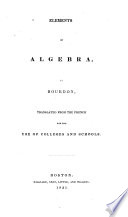 | Bourdon (M., Louis Pierre Marie) - Algebra - 1831 - 326 pages
...term is equal to the sum of the different products of these same second terms multiplied two and two ; the coefficient of the fourth term is equal to the sum of the different products, three and three. Following this analogy, we say that the coefficient of a term,... | |
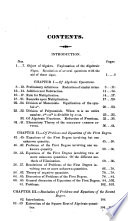 | Bourdon (M., Louis Pierre Marie) - Algebra - 1831 - 446 pages
...the third term is equal to the sum of the products of the different second terms taken two and two ; the coefficient of the fourth term is equal to the sum of their different products taken three and three. Reasoning from analogy, we 1st. product . . x3+ a +... | |
 | John Radford Young - Algebra - 1832 - 408 pages
...of the third term is equal to the sum of the products of every two roots with their signs changed ; the coefficient of the fourth term is equal to the sum of the products of every three roots with their signs changed, &c. ; and the last term is equal to the product... | |
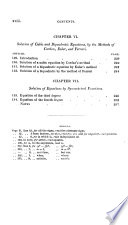 | John Radford Young - 1835 - 302 pages
...of the third term is equal to the sum of the products of every two roots with their signs changed ; the coefficient of the fourth term is equal to the sum of the products of every three roots with their signs changed; and so on: and the last term is equal to the... | |
 | Charles Davies - Algebra - 1835 - 378 pages
...the third term is equal to the sum- of the products of the different second terms taken two and two ; the co-efficient of the fourth term is equal to the sum of their different products taken three and three. Reasoning from analogy, we may conclude that the co-efficient... | |
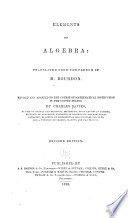 | Algebra - 1838 - 372 pages
...the third term is equal to the sum of the products of the different second terms taken two and two ; the co-efficient of the fourth term is equal to the sum -of their different products taken three and three. Reasoning from analogy, we may conclude that the co-efficient... | |
 | John Radford Young - 1839 - 332 pages
...of the third term is equal to the sum of the products of every two roots with their signs changed ; the coefficient of the fourth term is equal to the sum of the products of every three roots with their signs changed, &c. ; and the last term is equal to the product... | |
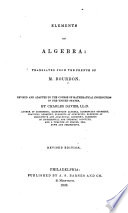 | Charles Davies - Algebra - 1842 - 368 pages
...the third term is equal to the sum of the products of the different second terms taken two and two ; the co-efficient of the fourth term is equal to the sum of their different products taken three and three. Reasoning from analogy, we may conclude that the co-efficient... | |
 | Charles Davies - Algebra - 1845 - 382 pages
...the third term is equal to the sum of the products of the different second terms, taken two and two ; the coefficient of the fourth term is equal to the sum of their different products, taken three and three. Reasoning from analogy, we may conclude that the co-efficient... | |
| |